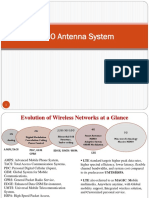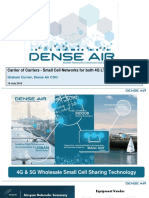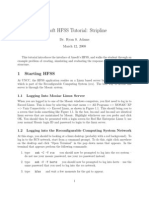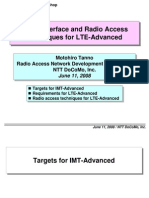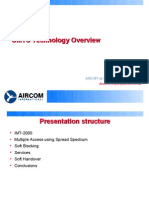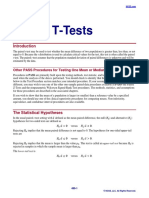LTE Path Loss
LTE Path Loss
Uploaded by
Singh KamaldeepCopyright:
Available Formats
LTE Path Loss
LTE Path Loss
Uploaded by
Singh KamaldeepCopyright
Available Formats
Share this document
Did you find this document useful?
Is this content inappropriate?
Copyright:
Available Formats
LTE Path Loss
LTE Path Loss
Uploaded by
Singh KamaldeepCopyright:
Available Formats
doc.: IEEE 802.
11-11/0272r0
Submission
February 2011
Ron Porat, Broadcom
Outdoor Path Loss Models for 802.11ah
Date: 2011-02-25
Authors:
Name Affiliations Address Phone email
Ron Porat Broadcom
16340 West Bernardo Dr., San
Diego, CA 92127
858-521-5409 rporat@broadcom.com
Vinko Erceg Broadcom
16340 West Bernardo Dr., San
Diego, CA 92127
Slide 1
doc.: IEEE 802.11-11/0272r0
Submission
February 2011
Ron Porat, Broadcom
Summary
Following the discussion in [4] on channel models, we add here additional
outdoor path loss models for Macro, Micro, Pico/Hotzone(Relay) deployments
based on 3GPP LTE assumptions and COST231 channel models
It is anticipated that some of the scenarios proposed for 802.11ah fit better
Hotzone deployments and some may fit better Macro deployments
Slide 2
doc.: IEEE 802.11-11/0272r0
Submission
Recap - LTE Macro Path Loss Models
Macro cell propagation model for urban area is applicable for scenarios in urban and
suburban areas outside the high rise core where the buildings are of nearly uniform
height which is assumed to be 12m
h is the antenna height above roof top levels and assumed 15m (we plot path loss with
2m antenna as well)
R is in [km] and f in [MHz]
With LTE assumptions we get 15.3+37.6*log10(d) at 2GHz and where d is the distance
in meters
Frequency dependency is seen in the term and contributes 7.3dB to the path
loss difference between 2GHz and 900MHz.
In the following, we concentrate on path loss at 2GHz since most LTE models assume
that frequency.
3
10 10 10
L 40 (1 4 10 h) log (R) 18 log (h) 21 log (f) 80dB
= + +
February 2011
Ron Porat, Broadcom Slide 3
10
21 log (f)
doc.: IEEE 802.11-11/0272r0
Submission
LTE Micro-cell system simulation parameters (Table A.2.1.1-4 [1])
February 2011
Ron Porat, Broadcom Slide 4
Parameter Assumption
Outdoor to indoor Out-door to outdoor
Cellular Layout Hexagonal grid, 19 cell sites, 1 sectors per site
Inter-site distance See A.2.1.1-2
Distance-dependent path loss
| | | |) ( log 56 7
10
m d dB L + =
includes penetration loss
| |
| |
| |
> +
s < +
=
m d m d
m d m m d
dB L
45 ) ( log 67 39
45 10 ) ( log 20 39
10
10
Lognormal Shadowing Similar to UMTS 30.03, B 1.41.4 [6]
Shadowing standard deviation 10 dB
10dB
Correlation distance of
Shadowing
10 m 25 m
Shadowing
correlation
Between cells 0.0
Between
sectors
na
Penetration Loss Included in Distance dependent pathloss model
Antenna pattern (horizontal)
(For omni cell sites with fixed
antenna patterns)
( ) 1 = u A
Carrier Frequency CF= 2GHz
Channel model According to Table A.2.1.2-1
UE speeds of interest 3km/h 3km/h, 30km/h
Total BS TX power (Ptotal) 38 dBm 10MHz carrier [7]
UE power class 21dBm (125mW). 24dBm (250mW)
doc.: IEEE 802.11-11/0272r0
Submission
Other Path Loss Models
COST 231 - This path loss model for Macro and Micro deployments is used in
the SCM channel model [3]
The Macro model is based on Hata model and assuming 2GHz frequency we get
35.2+35*log10(d) where d is the distance in meters
The Micro model is based on Walfish-Ikegami model and provides NLOS and LOS
models. The NLOS path loss model for 2GHz is 35.7+38*log10(d). The LOS model
for 2GHz is 35.7+26*log10(d)
802.11n path loss model assumes one breakpoint with LOS propagation up to
that point and an exponent 3.5 after
LTE-Advanced newer Pico path loss model [2] is 30.6+36.7*log10(d)
February 2011
Ron Porat, Broadcom Slide 5
doc.: IEEE 802.11-11/0272r0
Submission
Summary of Outdoor Path Loss Models at 2GHz
Note that Cost 231 Urban Macro, the new LTE-A Pico and LTE Macro with
2m antenna height exhibit similar path loss
February 2011
Ron Porat, Broadcom Slide 6
10
1
10
2
10
3
-180
-160
-140
-120
-100
-80
-60
-40
Path Loss Comparison at 2GHz
Tx-Rx distance [meters]
d
B
LTE Macro - 15m
LTE Macro - 2m
LTE Pico
COST231 Urban Macro
COST231 Urban Micro NLOS
LTE Micro Outdoor to Outdoor
11n model with bp=5m
doc.: IEEE 802.11-11/0272r0
Submission
LTE-A Path Loss Models
LTE Rel.10 [2] (LTE-Advanced) added newer low power Hotzone deployment
options and introduced newer path loss models that are partially based on
measurements conducted by China Mobile [5][6] and include a NLOS formula
and LOS formula.
Initially the two components were added together with a weight based on a probability function
but later on changed to be treated separately.
For consistency [6], the Macro model was changed to include a LOS model and
the NLOS model was adjusted
Hotzone Urban Model
PL
LOS
(d)=41.1+20.9log10(d)
PL
NLOS
(d)=32.9+37.5log10(d)
Prob(d)=0.5-min(0.5,5exp(-156/d))+min(0.5, 5exp(-d/30))
Macro Urban Model
PL
LOS
(d)=30.8+24.2*log10(d)
PL
NLOS
(d)=2.7+42.8*log10(d)
Prob(d)=min(1,18/d)*(1-exp(-d/63))+exp(-d/63)
February 2011
Ron Porat, Broadcom Slide 7
| | ( ) ( ) ( ) ( ) | | ( ) d PL d Prob d PL d Prob m d PL
NLOS LOS
+ = 1
doc.: IEEE 802.11-11/0272r0
Submission
LTE-A Hotzone Path Loss Models at 2GHz
February 2011
Ron Porat, Broadcom Slide 8
10
1
10
2
10
3
0
0.1
0.2
0.3
0.4
0.5
0.6
0.7
0.8
0.9
1
Tx-Rx distance [meters]
LOS probability
LTE-A Hotzone
LTE-A Macro
10
1
10
2
10
3
-160
-140
-120
-100
-80
-60
-40
Tx-Rx distance [meters]
d
B
Path Loss Comparison at 2GHz
LTE Macro
LTE-A Hotzone NLOS
LTE-A Hotzone LOS
LTE-A Hotzone Combined
LTE-A Macro NLOS
LTE-A Macro LOS
LTE-A Pico
doc.: IEEE 802.11-11/0272r0
Submission
Conclusions
Several outdoor path loss models are shown with some variation.
We note that Cost231 Macro Urban, Cost231 Micro Urban, LTE Hotzone
NLOS, LTE Pico and LTE Macro with antenna height 2m are very similar and
models from this set can be chosen.
In addition, a link budget calculation or system simulation should include the
following components:
Adjustment for different frequencies
Shadow fading with 10dB std
Penetration loss for indoor clients
February 2011
Ron Porat, Broadcom Slide 9
doc.: IEEE 802.11-11/0272r0
Submission
References
[1] 3GPP TR 25.814 - Physical layer aspects for evolved Universal Terrestrial Radio Access
(UTRA) Annex A.2 system simulation scenario
[2] 3GPP TR 36.814 - Further advancements for E-UTRA physical layer aspects, Annex A.2-
system simulation scenario
[3] 3GPP TR 25.996 - Technical Specification Group Radio Access Network; Spatial channel
model for Multiple Input Multiple Output (MIMO) simulations
[4] 11-11-0251-00-00ah-outdoor-channel_models-for-802-11ah.ppt
[5] 3GPP TSG-RAN WG1 #56bis, R1-091566, China Mobile, Vodafone - Relay to UE channel
model for LTE-Advanced
[6] 3GPP TSG-RAN WG1 #58, R1-093270, China Mobile - Consideration on eNB-UE channel
model
February 2011
Ron Porat, Broadcom Slide 10
You might also like
- S1-Flex Feature Parameter Description: Issue DateDocument60 pagesS1-Flex Feature Parameter Description: Issue DateAhmed YunesNo ratings yet
- Channel Coding in 5GDocument8 pagesChannel Coding in 5GAbdullatif AlsuwaidanNo ratings yet
- Radio Spectrum Management: Policies, Regulations and TechniquesFrom EverandRadio Spectrum Management: Policies, Regulations and TechniquesNo ratings yet
- Green Communications: Principles, Concepts and PracticeFrom EverandGreen Communications: Principles, Concepts and PracticeKonstantinos SamdanisNo ratings yet
- Performance Evaluation of Femtocell Analysis For Capacity and Throughput in Various Path Loss ModelsDocument4 pagesPerformance Evaluation of Femtocell Analysis For Capacity and Throughput in Various Path Loss ModelsInternational Journal of Innovative Science and Research TechnologyNo ratings yet
- GSM-To-UMTS Training Series 01 - Principles of The WCDMA System - V1.0Document87 pagesGSM-To-UMTS Training Series 01 - Principles of The WCDMA System - V1.0Naveed RamzanNo ratings yet
- 09 - MIMO Antenna System PDFDocument57 pages09 - MIMO Antenna System PDFArshwin KumarNo ratings yet
- Dense AirDocument38 pagesDense AirVaidehi JoshiNo ratings yet
- Smart AntennasDocument19 pagesSmart Antennasrvsharma02No ratings yet
- WCDMA/UMTS Overview WCDMA/UMTS Overview: Prepared by Ahmad Dedi Affandi Ericsson AB Sudan Ericsson AB SudanDocument58 pagesWCDMA/UMTS Overview WCDMA/UMTS Overview: Prepared by Ahmad Dedi Affandi Ericsson AB Sudan Ericsson AB Sudanmohamed fadlNo ratings yet
- LTE Field Meas EricssonDocument7 pagesLTE Field Meas EricssonPedro PrietoNo ratings yet
- 12 Spectrum - 5G Mobile and Wireless Communications TechnologyDocument15 pages12 Spectrum - 5G Mobile and Wireless Communications TechnologySornagopal VijayaraghavanNo ratings yet
- Spectral Efficiency of Wireless NetworkDocument274 pagesSpectral Efficiency of Wireless NetworkkhrumNo ratings yet
- Orthogonal Frequency Division Multiplexing (OFDM) : Concept and System-ModelingDocument31 pagesOrthogonal Frequency Division Multiplexing (OFDM) : Concept and System-ModelingAsif_Iqbal_8466No ratings yet
- Oea000040 Lte System Overview Issue 1.01Document97 pagesOea000040 Lte System Overview Issue 1.01Andri RayesNo ratings yet
- LTE Air Interface Courses: Leading Technology Training EvolutionDocument4 pagesLTE Air Interface Courses: Leading Technology Training EvolutionFouad BoutatNo ratings yet
- Basic Electronic Interview Questions and AnswersDocument18 pagesBasic Electronic Interview Questions and AnswersPuravRajNo ratings yet
- LTE Planning Principles Part II PDFDocument2 pagesLTE Planning Principles Part II PDFAnonymous 9GpQMmIwNo ratings yet
- WWW Mpirical Com Courses Lte Radio Network Planning 2 PDFDocument5 pagesWWW Mpirical Com Courses Lte Radio Network Planning 2 PDFYoucef BelhadiaNo ratings yet
- 5G Deployment Options Keysight May19Document8 pages5G Deployment Options Keysight May19Muhammad KaleemNo ratings yet
- 3G RF Planning OptimizationDocument1 page3G RF Planning OptimizationShalua YonahNo ratings yet
- Ericsson - Cell PlanningDocument5 pagesEricsson - Cell PlanningBassem AbouamerNo ratings yet
- Make 5G Backhaul Feasible Everywhere PDFDocument14 pagesMake 5G Backhaul Feasible Everywhere PDFMohamed IbrahimNo ratings yet
- Ber Performance Analysis of Ofdm-Mimo System Using Gnu RadioDocument34 pagesBer Performance Analysis of Ofdm-Mimo System Using Gnu RadioRounak RajNo ratings yet
- 04-WCDMA RNP LinkBudget - 20051214Document63 pages04-WCDMA RNP LinkBudget - 20051214Hidayat EncuhNo ratings yet
- Evdo 340Document172 pagesEvdo 340Vimal Raj UNo ratings yet
- BSC6900 Introduction - Documento HuaweiDocument9 pagesBSC6900 Introduction - Documento HuaweiMiguel Angel LopezNo ratings yet
- On Ramp Wireless White PaperDocument46 pagesOn Ramp Wireless White Paper1p8af2+b2hu00dxrn69c75% (4)
- Massive Machine Type Communications (MMTC)Document7 pagesMassive Machine Type Communications (MMTC)Ilmiawan ShubhiNo ratings yet
- Six Essential 5G Field Tests: Using Fieldfox Handheld AnalyzersDocument23 pagesSix Essential 5G Field Tests: Using Fieldfox Handheld Analyzersjohn BronsonNo ratings yet
- LTE Rel8 Downlink RLB (2014) (4x4)Document6 pagesLTE Rel8 Downlink RLB (2014) (4x4)mickyalemuNo ratings yet
- Performance Analysis of 5G Network Based On BDMA and Massive - MIMODocument9 pagesPerformance Analysis of 5G Network Based On BDMA and Massive - MIMOIJRASETPublicationsNo ratings yet
- NSN Active Antenna System White PaperDocument12 pagesNSN Active Antenna System White PaperAlfredo MoyanoNo ratings yet
- SCMADocument6 pagesSCMAjtafurpNo ratings yet
- Gaurav Chauhan RF Optimization & Planing Wcdma Lte NetworkDocument6 pagesGaurav Chauhan RF Optimization & Planing Wcdma Lte NetworkSahoo SKNo ratings yet
- Hfss TutorialDocument8 pagesHfss TutorialRizwan AhmedNo ratings yet
- Enabling Reuse 1 in 4G Networksv0.1Document5 pagesEnabling Reuse 1 in 4G Networksv0.1Tuvia ApelewiczNo ratings yet
- LteA Pres 0806 NttDoCoMoDocument38 pagesLteA Pres 0806 NttDoCoMogiocatsamacNo ratings yet
- SC-FDMA in LTEDocument16 pagesSC-FDMA in LTENgọc Nhã100% (1)
- How To Calculate Lte Maximum ThroughputDocument11 pagesHow To Calculate Lte Maximum ThroughputAbi AnnunNo ratings yet
- LTE in High Capacity Locations:: Einar FlobakDocument95 pagesLTE in High Capacity Locations:: Einar FlobakChinzo AltantuyaNo ratings yet
- WCDMA PrinciplesDocument41 pagesWCDMA PrinciplesmoussouniNo ratings yet
- Capacity Case Study - ShortenedDocument11 pagesCapacity Case Study - Shortenedcyo3fff100% (1)
- UMTS AircomDocument20 pagesUMTS AircomDũng PhạmNo ratings yet
- Nortel Fractional Reuse PlanningDocument17 pagesNortel Fractional Reuse PlanningWong_Hong_WeiNo ratings yet
- VoIP and Unified Communications: Internet Telephony and the Future Voice NetworkFrom EverandVoIP and Unified Communications: Internet Telephony and the Future Voice NetworkNo ratings yet
- Emerging Technologies in Information and Communications TechnologyFrom EverandEmerging Technologies in Information and Communications TechnologyNo ratings yet
- WCDMA: Requirements and Practical DesignFrom EverandWCDMA: Requirements and Practical DesignRudolf TannerNo ratings yet
- Radio Network Planning and Optimisation for UMTSFrom EverandRadio Network Planning and Optimisation for UMTSJaana LaihoRating: 4.5 out of 5 stars4.5/5 (2)
- Understanding UMTS Radio Network Modelling, Planning and Automated Optimisation: Theory and PracticeFrom EverandUnderstanding UMTS Radio Network Modelling, Planning and Automated Optimisation: Theory and PracticeMaciej NawrockiNo ratings yet
- Module 1 - Fundamentals of Fluid FlowDocument7 pagesModule 1 - Fundamentals of Fluid FlowClifford T NethercottNo ratings yet
- Solution: Permeability Vs % ThicknessDocument2 pagesSolution: Permeability Vs % ThicknessahmedNo ratings yet
- Topic 3: Kinematics in One DimensionDocument40 pagesTopic 3: Kinematics in One DimensionUmar ShahNo ratings yet
- Goyes 2021 ConsensusDocument6 pagesGoyes 2021 ConsensusROHIT ARORANo ratings yet
- Kebarangkali (BI)Document11 pagesKebarangkali (BI)smkpthoeNo ratings yet
- 6-Production From Two Phase ReservoirsDocument10 pages6-Production From Two Phase ReservoirsAgung Doank YessNo ratings yet
- LU 6 Mean ComparisonDocument73 pagesLU 6 Mean ComparisonKristhel Jane Roxas NicdaoNo ratings yet
- Mitschrift ExcerciseDocument18 pagesMitschrift ExcerciseJuKaschu0% (1)
- Old Quantum Theory - WikipediaDocument56 pagesOld Quantum Theory - Wikipediamahdy demareaNo ratings yet
- Types of Structures and LoadsDocument32 pagesTypes of Structures and LoadsIana Leyno100% (1)
- 1.1 & 1.2 14 (Paper-1-ISC) 31-03-2024 PaperDocument3 pages1.1 & 1.2 14 (Paper-1-ISC) 31-03-2024 PapershiviNo ratings yet
- How To Achieve Speed in Maths Calculations PDFDocument6 pagesHow To Achieve Speed in Maths Calculations PDFAnonymous 9Yv6n5qvSNo ratings yet
- Magic MathsDocument8 pagesMagic MathsAnonymous 5Qtn0QVDuONo ratings yet
- BasicTrigonometry BridgeCourse AnnotatedSlidesDocument8 pagesBasicTrigonometry BridgeCourse AnnotatedSlidesdumdummy524No ratings yet
- Excel 1 2 AssignmentDocument4 pagesExcel 1 2 AssignmentShobhit ShuklaNo ratings yet
- Paired T-Tests: Other PASS Procedures For Testing One Mean or Median From Paired DataDocument13 pagesPaired T-Tests: Other PASS Procedures For Testing One Mean or Median From Paired Datajay SinghNo ratings yet
- Ch1 - Part2 Binary OperationDocument24 pagesCh1 - Part2 Binary OperationnadhirahNo ratings yet
- CENV6134: Earthquake Engineering and Seismic Design of Steel BuildingsDocument2 pagesCENV6134: Earthquake Engineering and Seismic Design of Steel BuildingsJoaquin Ignacio Concha NúñezNo ratings yet
- Transcript - Ujjval ShahDocument2 pagesTranscript - Ujjval ShahUjjvalNo ratings yet
- Harvard Design Magazine - Current IssueDocument6 pagesHarvard Design Magazine - Current IssuenighbNo ratings yet
- Vibration Analysis On Electrode Column in AC EAF Based On Local Force Densities Developed by Rapid Change of Current and Arc StabilityDocument10 pagesVibration Analysis On Electrode Column in AC EAF Based On Local Force Densities Developed by Rapid Change of Current and Arc StabilityJJNo ratings yet
- All Stat For Eco - SumsDocument32 pagesAll Stat For Eco - SumsVs SivaramanNo ratings yet
- Antrodiction BKI REPORTDocument9 pagesAntrodiction BKI REPORTkareemNo ratings yet
- Basic Electronics TestDocument26 pagesBasic Electronics TestiqbaljuttNo ratings yet
- Udl and atDocument7 pagesUdl and atapi-475200562No ratings yet
- Ec 010 706 L 03 DipDocument7 pagesEc 010 706 L 03 DipAdarshNo ratings yet
- Modern Physics by TiplerDocument516 pagesModern Physics by Tipler9971553633100% (3)
- Math 542 Numerical Solutions of Differential EquationsDocument34 pagesMath 542 Numerical Solutions of Differential EquationsTaner YenerNo ratings yet
- Lecture 10 - Pulse Code Modulation IIDocument11 pagesLecture 10 - Pulse Code Modulation IInabeel hasanNo ratings yet
- John NapierDocument2 pagesJohn NapiergegiegNo ratings yet








